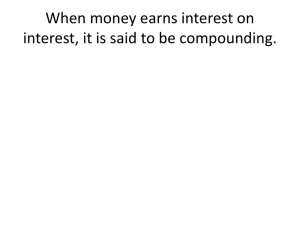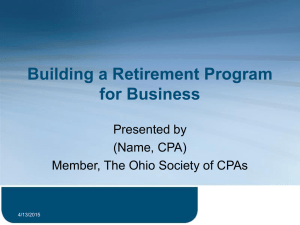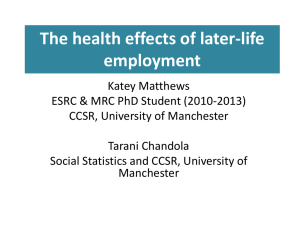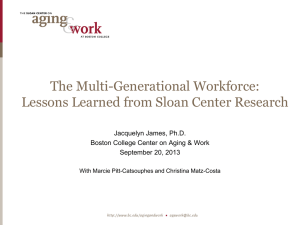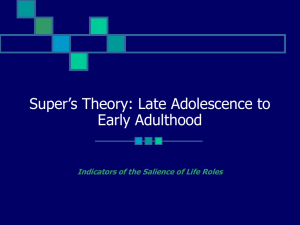THE BRAVE NEW WORLD OF RETIREMENT BENEFITS
advertisement
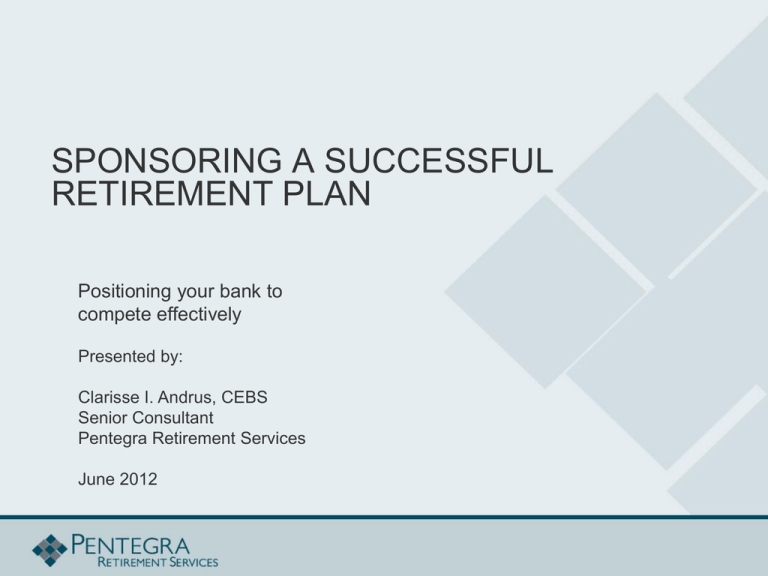
SPONSORING A SUCCESSFUL RETIREMENT PLAN Positioning your bank to compete effectively Presented by: Clarisse I. Andrus, CEBS Senior Consultant Pentegra Retirement Services June 2012 EFFECTIVE PLAN DESIGN CAN HELP ENSURE YOUR BANK’S SUCCESS Designing an effective retirement program means not only developing a plan that assists employees in meeting their retirement goals, but also addressing your bank's business needs All community banks share a similar goal—to attract and retain valuable employees in order to provide a high level of customer service that will enhance the growth and profitability of the institution DESIGNING AN EFFECTIVE RETIREMENT PROGRAM Designing the right retirement program for your organization begins with an understanding of: – Your management philosophy – Your compensation strategy – Competitive considerations and analysis – Demographic considerations – The maturity of your institution – The different types of plans available TRANSLATING BUSINESS OBJECTIVES TO BENEFITS PHILOSOPHY Two basic approaches used in developing a benefits philosophy Objective Approach—Compensation and benefits are offered in order to fulfill a specific function; benefit adequacy involves an analysis of what level of compensation and benefits allow an employee to maintain a certain standard of living Competitive Approach—Benefits and compensation packages are offered in order to attract and retain employees; benefit adequacy involves an analysis of wages and the level of benefits offered by competitors While these two approaches are different, they are not exclusive; a successful benefits program will reflect a blend of both philosophies HOW MUCH DO EMPLOYEES NEED? The objective approach involves examining the level of income needed in order to retire comfortably Replacement ratios are used as a tool in determining how much income a retirement program should provide A replacement ratio is the percentage of gross pay prior to retirement that one needs after retirement to maintain the pre-retirement standard of living Replacement ratios take into consideration the fact that the post-retirement standard of living will reflect lower taxes and other fixed costs THE OBJECTIVE APPROACH Experts recommend that employees retiring in the next few years will need between 70% and 90% of their pre-retirement income to maintain a similar standard of living in retirement These factors take into consideration the fact that post-retirement standards of living reflect lower taxes and other fixed costs They do not take into consideration the impact of inflation on purchasing power after retirement Replacement ratios THE COMPETITIVE APPROACH In order to remain competitive, plan sponsors must also analyze benefit programs in relation to peers While some turnover is unavoidable, plan sponsors that provide competitive benefit plans will generally experience lower turnover among middle and upper management positions While the cost of providing a competitive benefit program can be high, the cost associated with turnover or failure to attract and hire the professionals you need to run your business can be even more substantial In our experience, an employer’s overall retirement costs, exclusive of social security, are often in the 10-15% range THE COMPETITIVE APPROACH Our mutual institutions spent, on average, 9.3 percent of covered payroll for a defined benefit plan Our stock clients have an average cost of 7.8 percent for defined benefit plans More importantly, 31 percent of our mutual institutions have an average cost over 10 percent of payroll, while only 16 percent of stock institutions do Obviously, without other stock based capital accumulation plans, mutual institutions provide greater benefits under their defined benefit plan than stock institutions THE COMPETITIVE APPROACH Defined Benefit Plans can be structured with a cost as low as 4-5% of payroll and rarely exceed 15% In addition, the average employer contribution to a 401(k) plan among financial institutions was 3 percent of payroll 401(k) plans and profit sharing plans can range from just administrative costs to 25% of payroll Money purchase plans and leveraged ESOPs have a much wider range of costs starting in the range of 1-5% of payroll up to 25% A WIDE RANGE OF OPTIONS In summary, employers have a vast array of plan options to choose from in designing their retirement plans. There is no single best type Generally, employers should look to combining various types of plans Don’t need to necessarily spend a significant percent of payroll to have a competitive plan Goal: to balance providing appropriate benefit levels while being sure to consider IRS limits and deductibility along with demographics and competition YOUR INSTITUTION Plan design differs depending on whether or not you are a stock institution or mutual institution Stock institutions will typically integrate company stock with retirement plans Mutual institutions, without the ability to offer company stock based capital accumulation programs, will generally provide somewhat richer retirement plans by providing both a defined benefit plan and a 401(k) plan RETIREMENT PLAN OPTIONS Defined benefit plans – Pension plans – Cash Balance plans Defined contribution plans – 401(k) plans – Profit Sharing plans ESOPs – KSOPs Executive Benefit plans & BOLI WHAT’S THE BEST PROGRAM FOR YOUR BANK? Effective plan design combines elements of both the objective and competitive approach – Participant demographics – Maturity of institution – Competitive factors – Benefits philosophy – Compensation strategy and budget – Overall cost and benefit objectives “cost vs. adequacy” HOW DO YOU MEASURE THE EFFECTIVENESS OF YOUR RETIREMENT PROGRAM? Participation Rates Salary Deferral Rates Compliance Testing Asset Allocation Investment Strategy Investment Monitoring Fiduciary Responsibility Plan Fees Administrative Ease Employee Education ADDITIONAL PLAN DESIGN FEATURES TO CONSIDER Roth 401(k) Option Automatic Enrollment Qualified Automatic Contribution Arrangement (“QACA”) Safe Harbor 401(k) Options Safe Harbor Automatic Enrollment Catch-up contributions (age 50 and above) Loans Default Investment Alternatives Target Date Investment Funds Self Directed Brokerage Accounts CHOOSING THE RIGHT PROVIDER Reputation, history and stability Cost transparency Ability to provide a “total” retirement solution—bundled approach vs. unbundled approach Access to a team of retirement benefits experts (ERISA attorneys, actuaries, benefits consultants, investment managers and education specialists) available on a direct access basis NEXT STEPS Initiate review of retirement benefits strategy and coordination, including: – DB plan – 401(k) plan – Executive Benefit Plans Perform a plan review to determine the effectiveness of your retirement benefit plans THE PENTEGRA ADVANTAGE We believe we provide the best retirement plan value for community banks available today, and the unique benefit of working with a provider familiar with your employees’ needs that can offer insights about trends and competitive challenges in the community banking industry ABOUT THE SPEAKER Clarisse I. Andrus, CEBS is a Senior Consultant in the Midwest Region for Pentegra Retirement Services. Prior to this position, Clarisse was a Vice President for a major employee benefits consulting firm. Clarisse has more than 30+ years of experience in all aspects of employee benefits and retirement planning, with special emphasis on the design, funding, administration and implementation of qualified and nonqualified retirement programs. Clarisse has worked with many corporations on the strategic design and funding of retirement programs. Clarisse holds an M.A. in Speech Communications from Wayne State University and a B.A. with a double major in English and Journalism from Wayne State University. She also holds the Certified Employee Benefits Specialist (CEBS) designation and FINRA 6 and 63 Licenses. Clarisse has also been a speaker on various retirement topics at both local and national employee benefit seminars, conferences and events.

